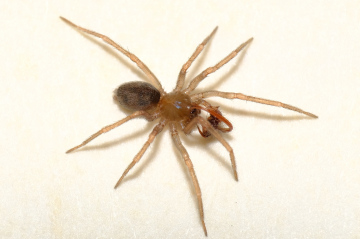Summary for Mastigusa arietina (Araneae)
previous species | next species
National Distribution
Terms of Use. Double-click on map to go to region

Explore Regional Distribution
Please log on and add a note on this species
About this species
Recorded altitude range
Species text
DistributionThe species has been recorded from Oxshott, Weybridge and Woking, Surrey; from Windsor Forest and Wellington College, Berkshire; and from Carlisle, Cumberland, though only a single wandering female was found in the last instance. A record from County Durham last century under the name Cryphoeca diversa proved to be false (Cooke 1967). It is fairly widespread in southern and central Europe.
Habitat and ecology
The species occurs only in the nests of the ants Lasius fuliginosus (Latreille) and L. brunneus (Latreille), which inhabit tree stumps and old trees. The latter species is found mostly in oaks in open country (Brian 1977). Adult males of the spider have been found in April and October, and females in January, April, July to October and December.
Status
All records are from the period 1892 to 1926. The spider was apparently found fairly frequently in ants' nests in Surrey and Berkshire by Donisthorpe in the first quarter of this century but has not been recorded since. This may be because ants' nests are rarely investigated by arachnologists. However, Roberts (1985) suggested that M. arietina and M. macrophthalma are forms of the same species, as their genitalia are identical and the only noticeable differences are in the eye size and arrangement.
Threats
The loss of over-mature trees from woodland and parkland. Unfortunately, this loss persists even within areas set aside for nature conservation, largely because those responsible for management do not always appreciate the value of the dead wood habitat and have seen the presence of dying trees as a sign of bad forestry.
Management and conservation
Over-mature trees and dead wood should be retained and a programme of long term replacement put into place to ensure continuity of suitable habitat.
Text based on Dawson, I.K., Harvey, P.R., Merrett, P. & Russell-Smith, A.R. (in prep.). References
Adult Season
Habitats
background methodology
Recorded management for locations with Mastigusa arietina
Recorded substrate and hydrology for locations with Mastigusa arietina
Images
please log on and upload a new image for this speciesSee also A-Z Species Index - A-Z Picture Index - previous species | next species
